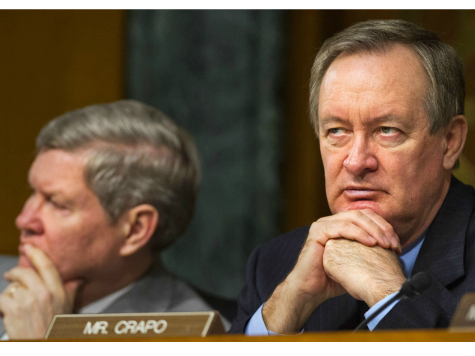
This week the Senate Banking Committee is scheduled to vote on a housing reform proposal sponsored by Senator Tim Johnson (D-SD), chairman of the committee, and Mike Crapo (R-ID), the ranking member. The bill would wind down Fannie Mae and Freddie Mac and replace them with a new agency, the Federal Mortgage Insurance Corporation (FMIC).
Advocates of the legislation are pushing hard to get the bill out of committee and to the floor of the Senate this year. However, frankly, the “reform” proposal falls short in a number of respects, most notably that it will simply create another monopoly in the world of housing finance for the government and largest lenders.
Strangely, supporters of Johnson-Crapo erroneously compare the FMIC to the Federal Deposit Insurance Corporation, an industry-funded mutual insurance scheme and prudential regulator that is nothing like the proposal the Senate Banking Committee will consider. A more apt metaphor is the existing model provided by the FHA and Ginnie Mae, two of the oldest and most important of the housing GSEs.
Thankfully, even were Johnson-Crapo to pass the Senate, its prospects in the House are dim at best. House Financial Services Committee Chairman Jeb Hensarling (R-TX) has authored his own housing overhaul legislation which would call for a drastically reduced role for the government in housing.
However, the conflict of visions between the House and Senate when it comes to housing is just the beginning of the problem.
A big part of the reason that meaningful housing reform is so difficult to achieve in Washington is that the industry is heavily subsidized and has been for decades. Housing industry lobbyists oppose any meaningful reform; realtors, homebuilders, lenders, and major Wall Street firms want continued government backing of mortgage loans and securities.
The supposed private shareholders of Fannie and Freddie, for example, including some of the most prominent Wall Street hedge funds and consumer advocates like Ralph Nader, want Congress to make them whole on their “investments.” They don’t care that taxpayers continue to shoulder the real liabilities associated with these ersatz housing agencies.
Private investors have never carried even a tiny fraction of the risk in housing going back to the Great Depression, in part because the risks of this $10-trillion market are too large. Fannie Mae and Freddie Mac are reporting record profits, all of which must be turned over to the US Treasury under the conservatorship that was put in place after the 2007 subprime crisis.
However, are the GSEs really profitable?
If you consider the vast subsidies pumped through Fannie and Freddie via government programs like Home Affordable Modification Program (HAMP) and The Home Affordable Refinance Program (HARP), and the interest rate subsidies from the Fed, not only do the supposed profits disappear, but neither agency is really solvent.
Factor in the additional subsidies via the Fed’s low-interest rate regime and the purchase of mortgage securities under “quantitative easing,” and the profitability of Fannie and Freddie becomes even more suspect. We have not even talked about the billions of dollars’ worth of foreclosed homes owned by each agency that are carried at “cost” under bizarre federal accounting rules.
Yet much of the thinking on Capitol Hill behind the Johnson-Crapo proposal is predicated on the fallacy that the GSEs actually make money. Indeed, if members of Congress bothered to read the latest earnings reports from the major banks, they would discover that lenders are losing several thousand dollars on every mortgage they make.
Both HAMP and HARP were massive subsidy programs for the banks and the GSEs which underwrite more than 90% of all mortgages in the US. The purpose of these programs was to kick the proverbial can down the road and buy time in the hope that the rising tide of a recovering housing market would lift all boats. Unfortunately, with home prices now starting to peak and even fall in some parts of the country, redefault events on subsidized loan modifications and refinancing are increasing “at an alarming rate,” according to the Office of the Special Inspector General for the Troubled Asset Relief Program (SIGTARP).
“The longer a homeowner remains in HAMP, the more likely he or she is to redefault out of the program,” SIGTARP states in its most recent report to Congress. The redefault rate among the oldest HAMP mortgage modifications is almost 50%. Moreover, many loans modified or refinanced at subsidized interest rates are now resetting to market rates, a fact that will drive defaults on HARP and HAMP loans steadily higher.
The whole process surrounding reform of the government role in housing has a certain fantasy-land atmosphere. Supporters of a strong government role cannot bring themselves to admit that the massive subsidies used to prop up home prices since the 2007-2009 subprime crisis must eventually come home to roost. Conservatives who want to see a reduction in the government role in housing don’t seem to appreciate what will happen as and when they get their way, namely a sharp reduction in mortgage lending volumes and home prices.
The Johnson-Crapo proposal represents the status quo in a new guise, but the real question that members of both parties in Congress need to ask is whether maintaining the status quo is even possible. The apparent stability in the US housing market is a function of massive subsidies, something that neither Democrats nor Republicans seem to understand. As the election approaches and home prices begin to fall later this year under the weight of a bad job market, flat to down consumer income, and rising interest rates, the political debate is likely to shift from reform of the government’s role to how to pump yet more subsidies into the housing sector.

COMMENTS
Please let us know if you're having issues with commenting.